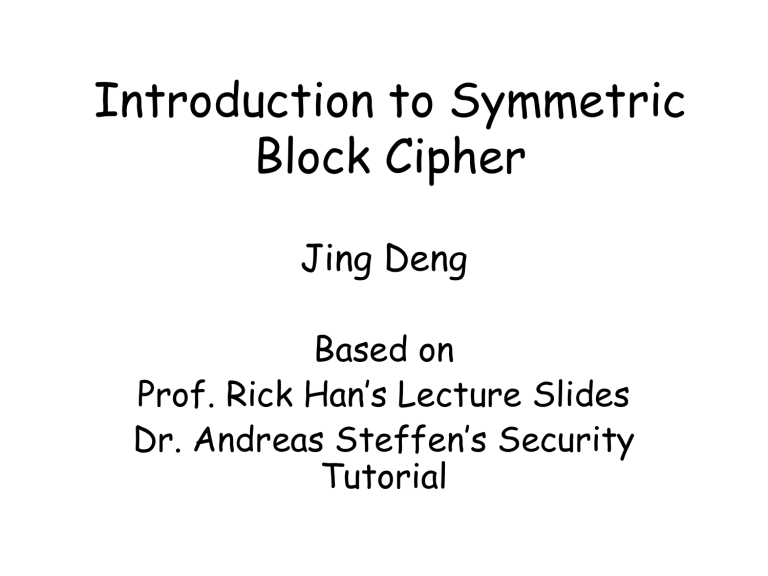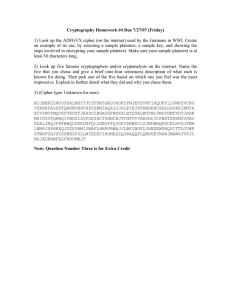
Introduction to Symmetric Block Cipher Jing Deng Based on Prof. Rick Han’s Lecture Slides Dr. Andreas Steffen’s Security Tutorial Cryptography plaintext ciphertext Encryption plaintext Decryption • Encryption algorithm also called a cipher • Cryptography has evolved so that modern encryption and decryption use secret keys • • Cryptographic algorithms can be openly published Only have to protect the keys plaintext ciphertext Encryption Key KA plaintext Decryption Key KB Symmetric-Key Cryptography plaintext ciphertext Encryption Key KA plaintext Decryption Key KB=KA Secure Key Distribution • • • Both sender and receiver keys are the same: KA=KB The keys must be kept secret and securely distributed • Thus, also called “Secret Key Cryptography” Data Encryption Standard (DES) Cryptanalysis • • Brute force: try every key Ciphertext-only attack: • • • Attacker knows ciphertext of several messages encrypted with same key (but doesn’t know plaintext). Possible to recover plaintext (also possible to deduce key) by looking at frequency of ciphertext letters Known-plaintext attack: • • Attackers observes pairs of plaintext/ciphertext encrypted with same key. Possible to deduce key and/or devise algorithm to decrypt ciphertext. Cryptanalysis (2) • Chosen-plaintext attack: • • Attacker can choose the plaintext and look at the paired ciphertext Attacker has more control than known-plaintext attack and may be able to gain more info about key • Adaptive Chosen-Plaintext attack: • Examples • Attacker chooses a series of plaintexts, basing the next plaintext on the result of previous encryption • • Differential cryptanalysis – DES is resistant it Linear cryptanalysis • Lossless compression before encryption removes redundancy • Cryptanalysis attacks often exploit the redundancy of natural language Examples • Simple and non-secure ciphers – – – – Shift Cipher – Caesar Cipher Affine Cipher Vigenere Cipher Hill Cipher • Information-secure cipher – One-Time Pad Confusion and Diffusion plaintext ciphertext Encryption Key KA plaintext Decryption Key KB • Terms courtesy of Claude Shannon, father of Information Theory • “Confusion” = Substitution • • a -> b Caesar cipher • • abcd -> dacb DES • “Diffusion” = Transposition or Permutation Confusion and Diffusion (2) • “Confusion” : a classical Substitution Cipher Courtesy: Andreas Steffen • Modern substitution ciphers take in N bits and substitute N bits using lookup table: called SBoxes Confusion and Diffusion (3) • “Diffusion” : a classical Transposition cipher Courtesy: Andreas Steffen • modern Transposition ciphers take in N bits and permute using lookup table : called P-Boxes Block Cipher • Divide input bit stream into n-bit sections, encrypt only that section, no dependency/history between sections Courtesy: Andreas Steffen • In a good block cipher, each output bit is a function of all n input bits and all k key bits Example: DES • Data Encryption Standard (DES) • • • • Encodes plaintext in 64-bit chunks using a 64-bit key (56 bits + 8 bits parity) Uses a combination of diffusion and confusion to achieve security Was cracked in 1997 • Parallel attack – exhaustively search key space Decryption in DES – it’s symmetric! Use KA again as input and then the same keys except in reverse order Example: DES (2) • DES • • • 64-bit input is permuted 16 stages of identical operation • differ in the 48-bit key extracted from 56-bit key - complex • R2= R1 is encrypted with K1 and XOR’d with L1 • L2=R1, … Final inverse permutation stage Example: DES (3) Beyond DES • Triple-DES: put the output of DES back as input into DES again with a different key, loop again: 3*56 = 168 bit key • Advanced Encryption Standard (AES) – Requirements: • shall be designed so that the key length may be increased as needed. • block size n = 128 bits, key size k = 128, 192, 256 bits – Candidates: MARS, twofish, RC6, Serpent, Rijndael – successor (Rijndael) Encryption Mode (ECB) • Electronic Code Book (ECB) mode for block ciphers of a long digital sequence • Vulnerable to replay attacks: if an attacker thinks block C2 corresponds to $ amount, then substitute another Ck Attacker can also build a codebook of <Ck, guessed Pk> pairs • Encryption Mode (CBC) • Cipher Block Chaining (CBC) mode for block ciphers • Inhibits replay attacks and codebook building: identical input plaintext Pi =Pk won’t result in same output code due to memory-based chaining IV = Initialization Vector – use only once • Stream Cipher • Stream ciphers • Rather than divide bit stream into discrete blocks, as block ciphers do, XOR each bit of your plaintext continuous stream with a bit from a pseudo-random sequence At receiver, use same symmetric key, XOR again to extract plaintext • Encryption Mode (OFB)



